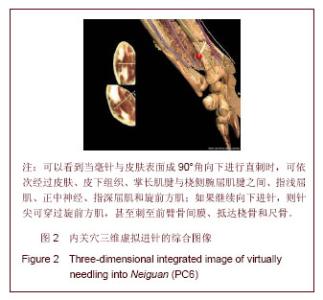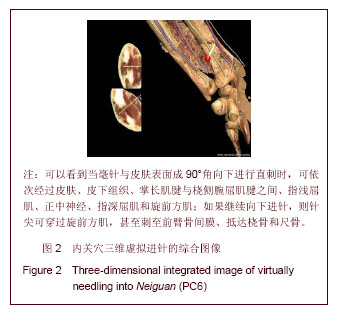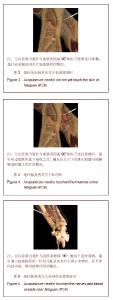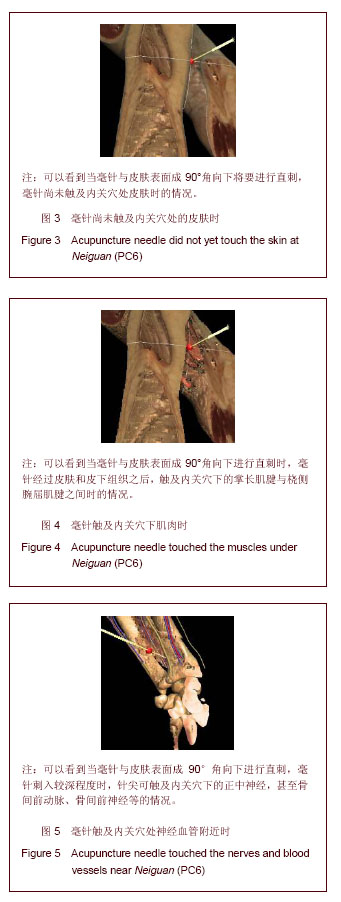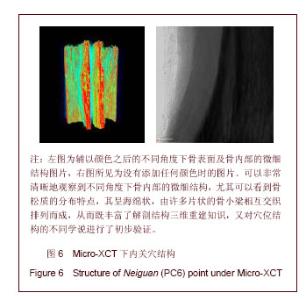| [1] 王书诚.低频电脉冲治疗原发性高血压的效果研究[J].临床和实验医学杂志,2010,9(9):657-658.[2] 王向英,张莉,王建成,等.针刺治疗假性球麻痹32例[J].江苏中医药,2006,27(9):61.[3] 叶德宝,方剑乔,宋莹慧,等.内关穴经皮电刺激对偏头痛急性发作患者TCD的影响[J].浙江中医学院学报,2003,27(4):68-70.[4] 温塘芳,陈云飞,刘凤梅,等.小剂量氟哌利多内关穴注射治疗术后顽固性呃逆临床观察[J].临床合理用药杂志,2009,2(5): 16-17.[5] You Q, Yu H, Wu D,et al.Vitamin B6 points PC6 injection during acupuncture can relieve nausea and vomiting in patients with ovarian cancer.Int J Gynecol Cancer. 2009; 19(4):567-571.[6] Wollaston DE, Xu X, Tokumaru O,et al.Patients with systemic sclerosis have unique and persistent alterations in gastric myoelectrical activity with acupressure to Neiguan point PC6.J Rheumatol.2005;32(3):494-501.[7] Kim H, Park HJ, Han SM,et al.The effects of acupuncture stimulation at PC6 (Neiguan) on chronic mild stress-induced biochemical and behavioral responses.Neurosci Lett. 2009; 460(1):56-60.[8] 易婧,杨莉,张彦妮.按压内关穴对皮试疼痛的影响[J].临床军医杂志,2007,35(5):777.[9] 潘莉,潘贵书.电针内关穴对海洛因依赖大鼠心率变异性的影响[J].包头医学院学报,2008, 24(5):448-451.[10] 蔡琛,吴俊梅,薛红,等.针灸治疗海洛因依赖选穴规律探究[J].成都医学院学报,2008,3(3):170-172.[11] 徐德国,戴启刚,常加松.侧脑室注射P物质对心肌缺血调整作用的机理研究[J].辽宁中医药大学学报,2008,10(6):201-202.[12] 王智君,李为民,Thomas Friedemann.针刺内关穴对正常麻醉大鼠血压的调节作用[J].上海针灸杂志,2009,28(3):175-178.[13] 付平,贾建平,闵宝权.针刺内关穴对阿尔茨海默病脑功能磁共振成像的影响[J].中华神经科杂志,2005,38(2):118-119.[14] Hübscher M, Vogt L, Banzer W.Laser needle acupuncture at Neiguan (PC6) does not mediate heart rate variability in young, healthy men.Photomed Laser Surg. 2007;25(1):21-25.[15] GB/T 12346-2006,腧穴名称与定位[S].2006.[16] 沈雪勇.经络腧穴学[M].北京:中国中医药出版社,2007:162-163[17] 石学敏.针灸学[M].北京:中国中医药出版社,2007:82.[18] 张吉.针灸学[M].北京:人民卫生出版社,2006:190-191.[19] 严振国.经穴断面解剖图解(上肢部分)[M].上海:上海科学技术出版社,1983:84-85.[20] Viceconti M, Clapworthy G, Van Sint Jan S.The Virtual Physiological Human - a European initiative for in silico human modelling.J Physiol Sci. 2008;58(7):441-446.[21] Spitzer VM,Whitlock DG.人体断层解剖学彩色图谱[M].天津:天津科学技术出版社,2002: 122-190.[22] 大卫•迪安,托马斯•赫伯纳. 人体断面解剖学与医学影像学图谱[M].郑州:河南科学技术出版社,2002:132-144.[23] (英)韦尔(Jamie Weir),亚伯拉罕斯(Peter H. Abrahams)著.陈宏颉,高进喜,李敬成,等译.影像解剖图谱[M].3版.福州:福建科学技术出版社,2006:160-204.[24] 主海文,刘有军,曾衍钧.血管图像分割技术的研究进展[J].北京生物医学工程,2005,24(2):155-159.[25] 庄天戈,严振国.基于中医理念的穴位融合的三维可视人[J].中国基础科学,2004,6(1):26-29.[26] Höhne KH, Pflesser B, Pommert A,et al.A realistic model of human structure from the visible human data.Methods Inf Med. 2001;40(2):83-89.[27] Pommert A, Höhne KH, Pflesser B,et al.Creating a high-resolution spatial/symbolic model of the inner organs based on the Visible Human.Med Image Anal. 2001;5(3): 221-228.[28] 沈雪勇.经络腧穴学[M].北京:中国中医药出版社,2007:289-296.[29] Goldman N, Chen M, Fujita T,et al.Adenosine A1 receptors mediate local anti-nociceptive effects of acupuncture.Nat Neurosci. 2010;13(7):883-888.[30] 丁光宏,魏瑚.经络实质的揭示是中医现代化的关键[J].世界科学技术-中医药现代化,2005, 7(5):107-112.[31] 张迪,丁光宏,沈雪勇,等.针刺引起结缔组织效应的研究进展[J].针刺研究,2004,29(1):77- 80.[32] 张维波,郭义,林玉英,等. 经络研究近50年回顾与今后研究方向[J].世界科学技术-中医药现代化,2005,7(5):99-104.[33] 秦翊麟.图像分割及其在虚拟人肌肉识别与胸片特征辨识中的应用研究[D].上海:上海交通大学,2006:13-22.[34] 单锦露,张绍祥,刘正津,等.中国数字化可视人女性盆腔的计算机三维重建[J].解剖学杂志,2005,28(3):337-339.[35] Schiemann T, Tiede U, Höhne KH.Segmentation of the visible human for high-quality volume-based visualization.Med Image Anal. 1997;1(4):263-270.[36] Spitzer VM, Whitlock DG.The Visible Human Dataset: the anatomical platform for human simulation.Anat Rec. 1998; 253(2):49-57.[37] 宋岳涛,尹岭.中国数字人数据库的构建与数据资源共享[J].中国医学影像技术,2006,22(9): 1306-1309. [38] GB12346-90.中华人民共和国国家标准•经穴部位[S].1990.[39] 钟世镇.数字人和数字解剖学[M].济南:山东科学技术出版社, 2004: 561-591.[40] 赵静,刘红菊,庄天戈,等.融合中医知识库的虚拟针灸三维浏览器[J].上海针灸杂志,2005, 24(2):29-32.[41] 耿宁,李晓箐,易新竹,等.显微CT在牙体解剖数字化教学中的应用[J].国际口腔医学杂志, 2010,37(1):10-13.[42] 陈方府,漆玉金,张雪竹.X射线显微CT成像的图像实时校正研究[J].核电子学与探测技术, 2009,29(4):910-913.[43] 郭义.实验针灸学[M].北京:中国中医药出版社,2008:362-417.[44] 王春田.基础医学实验动物操作基本技能[M].北京:中国医药科学技术出版社,2009:132-177.[45] 邓月良.经络的研究[J].医学研究通讯,2003,32(2):26-27 [46] 原林,焦培峰,唐雷,等.中医经络理论的物质基础-结缔组织、筋膜和自体监控系统[J].中国基础科学,2005,7(3):44-47.[47] 田宝俊,朱训生,章浩伟,等.基于运动控制针刺手法仪的工程研究[J].计算机工程与应用,2008, 44(20):206-207.[48] Heng PA, Wong TT, Yang R,et al.Intelligent inferencing and haptic simulation for Chinese acupuncture learning and training.IEEE Trans Inf Technol Biomed. 2006;10(1):28-41.[49] 刘文霞,王树杰,张继伟,等.虚拟现实技术在医学上的应用[J].生物医学工程学杂志, 2007,24(4):946-949. |
